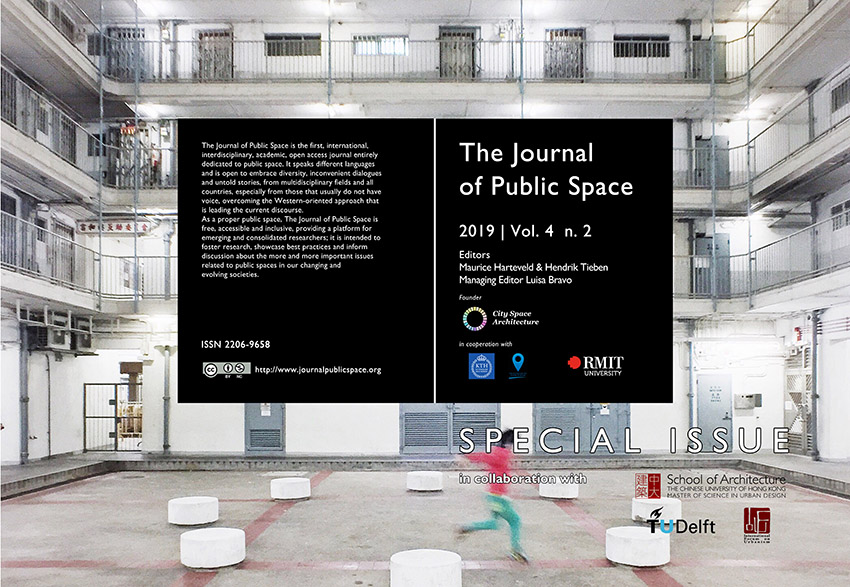Public Space in the Entrepreneurial City
##plugins.themes.bootstrap3.article.main##
Abstract
This issue of The Journal of Public Space explores the relationship between public space and entrepreneurship. The ideas developed during the Habitat III Conference in Quito, when considering: How to implement the ambitious aims of the New Urban Agenda in context of the current socio-economic realities and to reach a fairer share of the benefits brought by urbanisation? In December 2017, the organisation of the 10th Conference of the International Forum on Urbanism (IFoU) at the Chinese University of Hong Kong offered an opportunity to discuss such questions with international scholars and professionals. The papers in this special issue originated from this conference and later submissions to The Journal of Public Space.
##plugins.themes.bootstrap3.article.details##
The Authors retain copyright for articles published in The Journal of Public Space, with first publication rights granted to the journal.
Articles in this journal are published under the Creative Commons Attribution NonCommercial Licence (CC-BY-NC) - https://creativecommons.org/licenses/by-nc/4.0/.
You are free to:
• Share - copy and redistribute the material in any medium or format
• Adapt - remix, transform, and build upon the material
Under the following terms:
• Attribution - You must give appropriate credit, provide a link to the license, and indicate if changes were made. You may do so in any reasonable manner, but not in any way that suggests the licensor endorses you or your use.
• NonCommercial — You may not use the material for commercial purposes.
References
Bekkering, Henco, and Tieben, Hendrik (Eds.) (2018, December). “Urban design for an inclusive economy: part I,” ICE Journal Urban Design and Planning, Themed Issue, Vol. 171. No. 6, 229–230.
Cameron, David (2013, 6th of June). Cabinet Office in Prime Minister's speech at the Social Impact Investment Forum in London on 6 June 2013. Published online 6 June 2013: https://www.gov.uk/government/speeches/prime-ministers-speech-at-the-social-impact-investment-conference, retrieved 11 November 2019.
Chu, David K.W. (1983). Hong Kong: A Business Profile, In: Farmer, Richard N., and John V. Lombardi (1983) Readings in international business. Bloomington: Cedarwood Press.
Cuthbert, Alexander R. & McKinnell, Keith G. (1997), “Ambiguous space, ambiguous rights - corporate power and social control in Hong Kong”, Cities, Vol. 14, No. 5, 295-311.
Duany, Andres (2001). “Three cheers for gentrification”, The American Enterprise, Vol. 12, No. 3, April/May, pp. 36-39.
Gass, J. R. (1989). Towards an "enterprising" culture. A challenge for education and training. (Educational Monograph N°4) Paris: Organisation for Economic Co-Operation and Development (OECD) / Centre for Educational Research and Innovation.
Gaye, Malick (1996). Entrepreneurial cities, public services at the grassroots. (Occasional Papers No. 184-185). Dakar: ENDA Publications.
Griffiths, Ron (1998). Making sameness: Place marketing and the new urban entrepreneurialism. In: Oatley, Nick (ed.), Cities, economic competition and urban policy. London: Paul Chapman Publishing, pp. 41-57.
Goldsmith, Stephen, Rudolph W. Giuliani, and Richard M. Daley (1999). The entrepreneurial city: a how-to handbook for urban innovators. New York: Manhattan Institute for Policy Research (Center for Civic Innovation).
Harvey, David(1989). “From Managerialism to Entrepreneurialism: The Transformation in Urban Governance in Late Capitalism,” Geografiska Annaler. Series B, Human Geography, Vol. 71, No. 1, The Roots of Geographical Change: 1973 to the Present, 3-17, 7.
Hall, Tim & Hubbard, Phil(1998). The entrepreneurial city: geographies of politics, regime and representation, Chicester, England & New York: Wiley.
Mollenkopf, John Hull (1983). The Contested City. New Jersey: Princeton University Press.
Saunders, Doug (2012). Arrival City: How the Largest Migration in History Is Reshaping Our World, Vintage.
Spirou, Costas (2011). Urban tourism and urban change: Cities in a global economy. (The Metropolis and Modern Life). New York: Routledge.
Sullivan, Daniel Monroe (2000). Embeddedness and the Entrepreneurial City. (doctoral thesis) Madison: University of Wisconsin.
Tieben, Hendrik (2016).“Public Space Trends in Hong Kong. A View From The New Territories”, The Journal of Public Space, 1(1), pp. 25-34.
UN-Habitat (2013). Streets as Public Spaces and Drivers of Urban Prosperity, Nairobi: UN-Habitat.
UNESCO Principal Regional Office for Asia and The Pacific (1994). Becoming Enterprising, Technical Guidelines, compiled by The Asia-Pacific Centre of Educational Innovation for Development (ACEID). Bangkok, UNESCO Principal Regional Office for Asia and The Pacific.

